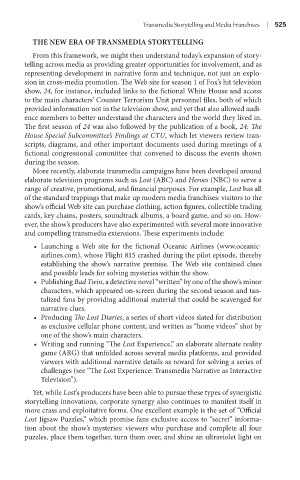Page 546 - Battleground The Media Volume 1 and 2
P. 546
Transmed a Storytell ng and Med a Franch ses |
ThE nEw Era oF TransmEDia sToryTELLing
From this framework, we might then understand today’s expansion of story-
telling across media as providing greater opportunities for involvement, and as
representing development in narrative form and technique, not just an explo-
sion in cross-media promotion. The Web site for season 1 of Fox’s hit television
show, 24, for instance, included links to the fictional White House and access
to the main characters’ Counter Terrorism Unit personnel files, both of which
provided information not in the television show, and yet that also allowed audi-
ence members to better understand the characters and the world they lived in.
The first season of 24 was also followed by the publication of a book, 24: The
House Special Subcommittee’s Findings at CTU, which let viewers review tran-
scripts, diagrams, and other important documents used during meetings of a
fictional congressional committee that convened to discuss the events shown
during the season.
More recently, elaborate transmedia campaigns have been developed around
elaborate television programs such as Lost (ABC) and Heroes (NBC) to serve a
range of creative, promotional, and financial purposes. For example, Lost has all
of the standard trappings that make up modern media franchises: visitors to the
show’s official Web site can purchase clothing, action figures, collectible trading
cards, key chains, posters, soundtrack albums, a board game, and so on. How-
ever, the show’s producers have also experimented with several more innovative
and compelling transmedia extensions. These experiments include:
• Launching a Web site for the fictional Oceanic Airlines (www.oceanic-
airlines.com), whose Flight 815 crashed during the pilot episode, thereby
establishing the show’s narrative premise. The Web site contained clues
and possible leads for solving mysteries within the show.
• Publishing Bad Twin, a detective novel “written” by one of the show’s minor
characters, which appeared on-screen during the second season and tan-
talized fans by providing additional material that could be scavenged for
narrative clues.
• Producing The Lost Diaries, a series of short videos slated for distribution
as exclusive cellular phone content, and written as “home videos” shot by
one of the show’s main characters.
• Writing and running “The Lost Experience,” an elaborate alternate reality
game (ARG) that unfolded across several media platforms, and provided
viewers with additional narrative details as reward for solving a series of
challenges (see “The Lost Experience: Transmedia Narrative as Interactive
Television”).
Yet, while Lost’s producers have been able to pursue these types of synergistic
storytelling innovations, corporate synergy also continues to manifest itself in
more crass and exploitative forms. One excellent example is the set of “Official
Lost Jigsaw Puzzles,” which promise fans exclusive access to “secret” informa-
tion about the show’s mysteries: viewers who purchase and complete all four
puzzles, place them together, turn them over, and shine an ultraviolet light on

